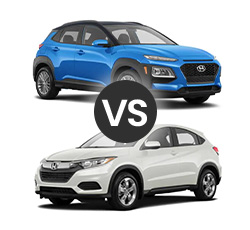2021 Hyundai Kona vs Honda HR-V
As far as SUVs go, the Hyundai Kona and Honda HR-V are two excellent choices. They're made by companies that have rightfully earned their strong reputations, and these models are ones that people can drive with confidence. Both of these models are youthful and modern in style, and as smaller crossovers, they have the size that many customers are looking for. This overview will go over how they differ so that prospective buyers can more easily determine which model would be the right pick.
The Powertrain
The Hyundai Kona and Honda HR-V offer drivers different amounts of power due to their available engines. A modest four cylinder engine lies under the hood of the HR-V, offering 141 horsepower and 127 pound-feet of torque - an amount which may not be as thrilling but can still satisfy many customers. Lower trims from Hyundai's line are outfitted with a 2 liter four cylinder producing 147hp and 132 lb.-ft., granting additional capability for those looking for more oomph in their ride.
Kona models are empowering drivers with a range of options. Whether you're looking for the classic efficiency that comes from standard 1.6-liter naturally aspirated engines or seeking to upgrade power and performance, upgrading trims will give you access to turbocharged 175 horsepower and 195 pound-feet torque motors – perfect for those who want an extra boost behind the wheel! All-wheel drive is also available as an optional add on at additional cost; providing unparalleled control no matter what conditions arise whilst driving.
Hyundai equips the Kona with a choice of transmissions, tailored to suit your driving style. The standard engine is paired with an efficient six-speed automatic SHIFTRONIC transmission while those seeking something sportier can opt for the turbocharged model featuring EcoShift dual clutch technology - normally found in premium performance cars. To ensure optimal control, all Kona's come complete with Drive Mode Select – offering Normal and Sport modes at just a switch away.
Honda chose a different approach for the HR-V's transmission, opting for a continuously variable one. While it may be difficult to distinguish from that of the Kona, drivers will appreciate its smooth operation and control provided by Sport mode and paddle shifters on three out of four trims. For eco-friendly performance without sacrificing power output – Eco Assist is available across all trims.
The HR-V's Hill Start Assist feature is an incredibly useful safety measure, allowing drivers to safely transition from the brake pedal to gas when confronted with uphill terrain. To activate it, simply engage your brakes for a moment and feel secure in knowing that you have extra support against any backward roll as you accelerate forward.
The Kona and HR-V do pretty well in the efficiency department. The Kona either has an estimated 27/33 (city/highway) or 28/32 miles per gallon, depending on whether it has the non-turbo or the turbo engine. The HR-V can achieve an estimated 28/34 miles per gallon, so it has the slight edge. With both models, fuel economy is lowered by a few miles per gallon if all-wheel drive has been installed.
Drivability
Both crossovers offer a surprisingly agile ride, perfect for those who desire something sportier. The Honda HR-V has the edge when it comes to cabin quietness thanks to its advanced Active Noise Cancellation system which cancels out engine noise. Meanwhile, customers looking for extra power will find just that in Hyundai Kona's turbocharged engine – offering impressive strength and smooth performance sure to thrill drivers everywhere.
Despite the Hyundai Kona and HR-V's versatile cabins, their compact sizes make them ideal for urban living or smaller parking spaces. While they have similar widths, the Kona is slightly shorter than its counterpart with a length of 164 inches versus 170 inches on the Honda model. Height differences between these two crossovers are also notable; The GHR-V stands taller when it comes to both ground clearance and overall vehicle height compared to its competitor cousin - perfect if you're looking flex your driving options in any terrain.
With its greater length, the HR-V has more passenger space. In the front, there is 41.2 inches of leg room, and it may surprise some people that it has 39.3 inches of leg room in its second row. This is more than what may larger SUVs can offer. In the Kona, there is 41.5 inches of leg room in the first row, but there's a mere 34.6 inches of second-row leg room. Whenever adults or taller children have to sit in the back of the Kona, they'll notice this lack of space.
The Honda HR-V offers drivers a more versatile cargo experience: 24.3 cubic feet of rear storage space can quickly grow to 58.8 with the second row folded down, while the Kona's 19.2 and 45.8 offerings pale in comparison against these numbers alone — not to mention that clever Magic Seat feature! It allows for taller items like bicycles or outdoor gear to be easily tucked away under its hidden seat cushion flap - perfect for those who need extra room on long road trips without needing an SUV’s full size dimensions.
The HR-V offers drivers plenty of space, but if you're after the latest tech features then look no further than the Kona. It comes with an array of infotainment options -- from seven or eight inch touchscreens and Android Auto & Apple CarPlay integration to SiriusXM Satellite Radio, two USB ports, HD radio capabilities and wireless charging. For those looking for that added luxury feel there's even a top Ultimate trim which includes integrated navigation plus a head up display alongside Infinity Premium audio systems' 8 speakers.
The Kona's Ultimate trim is equipped with an advanced cruise control system, making long highway drives that much simpler. Smart Cruise Control can sense when the leading vehicle slows down and automatically adjusts the speed of your car accordingly – providing a smooth drive in even heavy traffic.
In contrast, the HR-V doesn't have a touchscreen in all of its trims. Its base model has a five-inch LCD screen as opposed to the seven-inch touchscreen that all of the other trims have. Those higher trims have Honda Link, Pandora compatibility, Apple CarPlay, and android Auto, but the base model is limited to having Bluetooth. The top two trims of the HR-V have SiriusXM and HD Radio, and unfortunately, navigation is not a standard component of any HR-V trim. The best audio package that the HR-V can have would consist of six speakers.
Like the Kona, the HR-V can have smart cruise control. Honda uses the term "adaptive cruise control." It's found on the top two trims.
To avoid overpaying on a new car, shop prices online first. Get up front pricing before you walk into a dealership. We recommend the following free services; Car Clearance Deals, NADAguides, CarsDirect & & Motortrend.
These free services will offer you the lowest prices and supply you with multiple competing price quotes. You will know the best price before you visit the dealer.
Safety
The Hyundai Kona is the ultimate driving companion. With a range of driver-assist features such as forward collision-avoidance assist, lane keeping assistance, and an attentive eye – the Kona offers drivers peace of mind in any situation on their journey. This innovative vehicle will alert you if it senses that your attention has wandered away from the road while steering to get back into line whenever needed - this cutting edge model really does have its eyes firmly fixed on safety for all those behind its wheel.
Moving up a trim from the Kona's base model to the SE is associated with having even more driver-assist systems. The entry-level trim is the only one that doesn't have blind spot collision warning, rear cross-traffic collision warning, and lane change assist. These can all be useful considering that it's difficult to always know where surrounding vehicles might be at any given moment.
The Honda HR-V is well equipped when it comes to safety with driver assist components like the Honda Sensing suite, included in the two highest trims. This includes collision mitigation brakings and forward collision warning as well as lane departure warnings with road departure mitigations for added precaution. Further adding to its impressive arsenal of features, drivers can enjoy a blind spot feed through an innovative system called LaneWatch - available only on select models!
Which Has the Best Value?
Hyundai Kona offers six unique trims ranging from the economical SE all the way up to their top-of-the line Ultimate. Each trim comes with a variety of features, so customers can choose one that meets both their budget and lifestyle needs. Starting at an affordable $20,500 for the SE model and going up to $28,150 for the cutting edge Ultimate package - there is something available within everyone's price range.
The Kona makes a statement with two trims available - the Night trim showcasing sport pedals and gloss black accents for an edgy vibe, while the SEL Plus offers power adjustable driver's seat and enhanced sound system. Both benefit from luxurious amenities such as leather seating, heated front seats, wireless charging plus added safety features including auto-dimming rearview mirrors featuring HomeLink technology & proximity key entry on select models.
The Kona takes luxury and safety to the next level, offering two luxurious trims - Night trim with sport pedals for an edgy vibe and SEL Plus that boasts a power-adjustable driver's seat plus enhanced sound system. Both models come equipped with leather seats, heated front seats wireless charging, auto-dimming rearview mirrors as well as HomeLink technology in addition to proximity key entry on the SEL model. Enjoy peace of mind knowing you are safer than ever before.
Which is Better?
Cruise to your next adventure in style with the Hyundai Kona. At its lower trims, it provides a more affordable option than the Honda HR-V but offers even greater bang for your buck at higher levels of trim; delivering an experience that is unparalleled by many other similar crossovers on offer these days due to its turbocharged engine and advanced technology which keeps you entertained as well as safe when out on the road.
When making the decision between the Hyundai Kona and Honda HR-V, customers must take into account their individual preferences. The HR-V offers a generous amount of second row legroom and cargo capacity - perfect for those needing extra space! If tech features are more important, then opting for one of its higher trims will offer access to an arrayed selection options. Ultimately it comes down to size versus technology; which is worthier?

Get up to 4 local dealers to compete for your business by offering free, competitive pricing. Know before you go to the dealer.
Every dealer offers a secret price. Find yours here.
• 2021 Hyundai Kona VS Honda HR-V
• 2021 Hyundai Kona VS Kia Seltos
• 2021 Hyundai Kona VS Kia Niro
• 2021 Hyundai Kona VS Subaru Crosstrek


